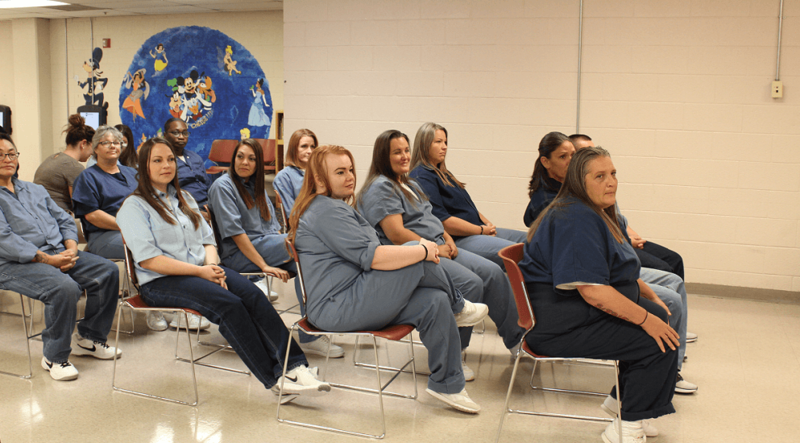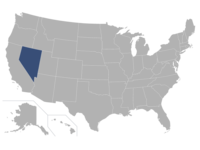Growing number of Nevada women incarcerated for non-violent crimes

Nearly 80 percent of the 1,200 women imprisoned in Nevada are incarcerated for non-violent crimes, often as not a drug-related offense. Last year, more than half of women who entered prison were first-time offenders. And in Nevada, as in the nation, the incarceration rate for women is rising faster than for men.
While Nevada policymakers research the state’s increasing incarceration rate and ways to remedy it, criminal justice experts have a message for lawmakers: Don’t forget women.
A recent report from the Crime and Justice Institute shows that Nevada’s female inmate population has grown 39 percent in the last decade.
In August, Gov. Brian Sandoval ordered up a review of Nevada’s justice system. As part of that review, funded by the Justice Reinvestment Initiative, the Crime and Justice Institute is compiling baseline data on sentencing, release and other corrections statistics Nevada.
The organization made its first presentation to the Advisory Commission on the Administration of Justice Sept. 12. The commission is scheduled to meet again Wednesday and one last time in November.
While the overall prison population in the United States has declined 7 percent, the report showed Nevada’s has increased by 7 percent in the last decade. That increase includes the female rate.
“A gender responsive strategy understands that gender matters,” says Emily Salisbury, an associate professor at UNLV. “A women’s experience in this world is not the same as a man’s (experience).”
“Women aren’t engaging in more criminal behavior than they were before,” Salisbury says. “There was a slight uptick in simple assault. But lots of criminologists will tell you women aren’t becoming more violent. What has changed is our policies and procedures. They are designed for men and then applied to women.”
About four out of five women inmates in Nevada are there for non-violent offenses.
As Nevada’s incarceration population grows and lawmakers decide what policies need to be enacted to address that growth, Salisbury says women’s interactions with the justice system and unique challenges they face need to be taken into consideration.
“Every state is going through the same issue”
There are an estimated 111,000 women in prisons in the United States according to the Sentencing Project. The rise of women entering the justice system isn’t a problem isolated to Nevada.
“Every state is going through the same issue,” says Harold Wickham, the deputy director of operations with the Nevada Department of Corrections.
The Sentencing Project says the number of women in prison has increased 50 percent faster than men since the 1980s.
As with any criminal justice issue, there’s a racial disparity. African-American women are imprisoned at twice the rate, and Hispanic women at 1.4 times the rate, of white women. According to the Sentencing Project, the rate of imprisonment for black women has been declining while the rate for Hispanic women is rising.
Salisbury points to the war on drugs campaign and the development of aggressive policies to combat it as the reason more women end up behind bars. While criminal drug policy has adversely affected incarceration rates in general, she adds it has been particularly hard on women — especially women of color.
“If you look at the data by gender, you’ll start to see women have disproportionately more drug crimes,” she says.
The number of women in U.S. prisons for drug crimes increased from 12 percent of the incarcerated population in 1986 to 25 percent in 2016, according to the Sentencing Project.
Other common infractions for women include property crimes such as burglary and theft.
The data compiled by the Crime and Justice Institute tells a similar story in Nevada.
Imprisonment for trafficking of a controlled schedule 1 substance — a category B felony that comes with up to a 20 year sentence — grew by 72 percent in the last decade. For attempted burglary, the increase is 52 percent.
Fifty-five percent of Nevada’s female incarcerated population is there on a first-time offense. That’s in keeping with the Nevada prison population in general. Nevada has several crimes for which imprisonment is mandatory, including DUI felonies, and many drug-related felonies. Prior legislative studies have found that more than half of the state’s prisoners, whatever their gender, are first-time offenders.
Policies don’t often reflect the reasons women are incarcerated. “Our policies have changed to be more punitive toward men, which impacts women,” she says.
Imprisoned and pregnant
There are about 1,200 women incarcerated in Nevada, which is 9 percent of the overall prison population. Florence McClure Women’s Correctional Center, the only facility expressly designated for women, houses 993, which makes it overcapacity by about 40.
The Jean Conservation Camp, a minimum-custody facility that allows women to work at the Nevada Division of Forestry, and the Casa Grande Transitional Housing Center in Las Vegas holds the remaining women.
Wickham says like many places, Nevada is still figuring out the specific problems women face while behind bars. “Most places that incarcerate women use the same model as they do with men,” he says. “You have to change that. If we treat them like men, they are going to act like men.”
Part of it is perception. People’s perspectives of prisons only take into consideration incarcerated men. “The thought is that female institutions are less dangerous — there is some truth to that — but as a result they are often an afterthought,” Salisbury says.
Wickham says having only one main facility presents another issue. If two men have a problem, they can move them to different prisons if necessary. “Since there is only one women’s prison, that’s a huge challenge,” he says. “If someone has a problem with another inmate and they don’t get along, that’s just too bad. That can be really challenging.”
Salisbury says the justice system in general fails to recognize that a significant number of women incarcerated are dealing with mental health issues, substance abuse or trauma from a sexual assault. “We have to recognize trauma from victimization manifests in different ways,” she says.
According to the Crime and Justice Institute, 52 percent of the female population has mental health needs. While the report didn’t indicate the number of inmates who have experienced past sexual violence, the National Sexual Violence Resource Center estimates one in three women will experience some form of sexual violence in their lives.
Wickham says women’s facilities have different health care needs.
Last year, Florence McClure Women’s Correctional Center had 12 pregnant inmates at once. Meeting the mandated staffing needs when they were in the prison hospital presented a huge strain on the rest of the facility. “And it cost millions in overtime budget,” he says.
Once they give birth, women have to sign over their custody to a guardian. “Someone has a child taken away, that’s another trauma within itself,” Wickham says.
Other prisons across the country have adopted programs and even installed nurseries that allow women to keep their children for a period of time. Wickham says they have looked at other state models, but ultimately didn’t have the resources to do a similar program.
Salisbury says mothers who are incarcerated eventually go home to become the primary caregivers to their children. They are met with different obstacles than men who go home to their families.
It can already be difficult for formerly incarcerated individuals to find employment and well-paying jobs — lack of both increases their chances to recidivate. “Women are less likely to have social and human capital,” Salisbury adds. “We still live in a world where women make 88 cents to (a dollar) a man makes.”
Even when helping with re-entry programs, Salisbury says efforts have to recognize that women are up against different odds when being released.
Though the system is outdated, Wickham adds the department has made recent advancements to address it. “Nevada is at least aware of its issues and working to make a difference,” Wickham says.
Brooke Santina, the spokeswoman for the department of corrections, says in the last three years — when James Dzurenda took over as the director — the department eliminated unnecessary programs. “Now, we only use evidence-based programs that have at least three-years worth of data,” she says.
There have been recent programs to help prepare women for re-entering society such as a cosmetology licensing programs, which is about two-years-old and has had 27 graduates. “This helps them get jobs once they leave,” Santina says.
A recent pilot program with CSN, which had its first round of graduates in June, also allows inmates to obtain college credit and receive OSHA and CPR certifications, which will potentially aid them in applying for various jobs — the program is partnering with the Laborers Union Local 872 to give inmates an opportunity to get connected to the union, gain mentorship and find jobs upon release.
Whatever success is achieved by current programs is always under threat of underfunding, Wickham says.
“Money is definitely an issue, but that’s not just with women,” he says. “If we had more staffing, we could do more programming. We do the best with what we can.”
Gender-specific solutions
With grant funding and bills spurred by the Justice Reinvestment Initiative, other states have been looking at policies to decrease prison populations.
Salisbury says some states start to see incarceration rates decline in the male population, but fail to see the same results for women. “They’ve put in great policies without asking if these policies should look different for women,” she says. “States that are starting to see a reduction in recidivism rates and incarceration rates for men don’t see similar outcomes for women.”
This was the case in Oregon. In 2013, the state passed legislation based on data collected through the Justice Reinvestment Initiative. After examining its results, they discovered women were being left behind.
“We were forced to have the conversation after the fact,” says Mike Schmidt, the executive director of the Oregon Criminal Justice Commission.
Since then, the state has crafted new policies that have helped incarcerated women — including keeping them out of prison in the first place.
The Family Sentencing Alternative Program, which allows primary parents facing prison sentences to be diverted from prison — but intensely supervised — to continue parenting. This is open to all inmates, but has a larger amount of women who benefit from it.
There are heavy restrictions such as house arrest with electronic surveillance. Participants might also have to undergo judge-mandated parenting classes, mental health treatment, or drug and alcohol rehabilitation.
“But these people would have been in prison without it,” Schmidt says.
In Nevada, the Crime and Justice Institute’s research is expected to guide the crafting of legislation. Meantime, the Nevada Department of Corrections has filed several bill draft requests that would do anything from establishing programs of treatment and aftercare for offenders with substance use disorders to allowing prisoners to have conjugal visits with their significant others.
But going forward, Salisbury encourages Nevada lawmakers to think about what policies would mean for women.








